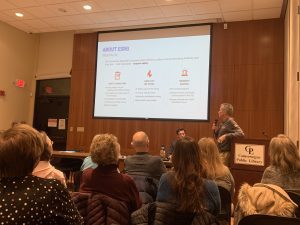An opportunity to build trust
It was heartening to read Daniel Dunaief’s interview with the new Suffolk County Police Commissioner Kevin Catalina [“New Suffolk County Police Commissioner Kevin Catalina discusses highway, school safety,” March 9] discussing school and road safety, adoption of body cameras and the importance of recruiting new officers from underrepresented communities.
Of some concern, though, is the comment that Catalina and the Suffolk County Sheriff traveled to El Salvador to learn police recruitment ideas. Since 2019 El Salvador has become a single-party dictatorship that has suspended the rule of law, civil rights and human rights in order to suppress gang violence. And the current U.S. federal administration is paying El Salvador to imprison Venezuelan deportees without due process. Probably not the best place to learn about good policing.
Notably absent from the article was any query about whether the SCPD intends to continue spending taxpayer money to fight the 2022 Newsday/New York Civil Liberties Union lawsuit against them. In 2020, New York State repealed the 50-A law that allowed departments to keep police complaint and disciplinary records secret. Since 2020, Newsday and the NYCLU have filed 10 Freedom of Information Law requests to SCPD that have still not been satisfied, even after a lower court and an appellate panel ruled against them. This February, New York’s highest court issued a ruling on the same kind of case (against the Rochester PD) requiring full disclosure of all records, regardless of outcome or when the complaint was made. Why continue spending money on a legal fight they will certainly lose?
If Commissioner Catalina would genuinely like to turn the page, and build community trust through transparency, now would be a good time to simply comply with the law.
John Hover
East Setauket
When is enough enough?
I want to thank Councilmember Jonathan Kornreich (D-Stony Brook) for his article in The Port Times Record [March 13, “Your Turn: Overdevelopment will not solve the affordable housing crisis”].
The article supports my ongoing concern that Port Jefferson village should stop approving permits to build new apartment buildings.
I recently tried to obtain the number of apartments and the number of residential homes currently in Port Jefferson village and was told that the village does not have this information. I must ask how the planning board and the Building and Planning Department can make educated rulings if they don’t even know how many exist and what the Village Master Plan considers the maximum that should be allowed. If there are no limits, the trend will just continue until Port Jefferson has lost all the charm of a small, historic village.
From my research, the Village of Port Jefferson already has over 1,100 apartments located in apartment buildings. This doesn’t include the three apartment buildings now being discussed in the Building and Planning Department and all the apartments that exist above the stores in our downtown and uptown.
We are a small village and 1,100+ apartments is more than the village can hold and still maintain its history and charm. I imagine that compared to other villages and hamlets in the area, Port Jefferson village outshines them in trying to meet the needs of people who find home ownership unobtainable.
I believe that the residents of Port Jefferson village need to decide if they want to maintain what’s left of the village’s history and charm or continue the trend of building massive apartment buildings and maybe one day being the new “Queens or Brooklyn” of Long Island.
We will only be able to stop this trend by ensuring that we elect village officials who will determine the number of apartments existing and the number that is acceptable. I believe something is lacking when no official in the village can easily obtain this information nor provide a number that a master plan states is acceptable.
Rob Grimm
Port Jefferson
BESS implications
In a recent letter to the TBR News Media, Peter Bond took issue with a previous letter from me regarding the capability of a battery energy storage system lithium-ion battery unit to power homes. In my calculation, I used 5,000 W as an estimate of the power used by a typical home, which was characterized by Bond as unjustifiably high.
To derive this number, I consulted my PSEG electrical energy bill from Aug, 20, 2024, which stated that my home energy from July 12 to Aug. 12 of 2024 was 1,978 kWh for the 720-hour period, or an average of 2,747 W during each day. However, as we know, the energy used during the hot summer is not even nearly constant during each day, and the hottest 4-hour period of the day can easily utilize twice as much energy as the average value for that day. In this case, therefore, the average power used in my home during this hot 4-hour period was calculated to be 5,494 W.
The PSEG report also provides the consumed energy during this period for an “average home,” which is 1,355 kWh. Using this number in a similar calculation provides an average 4-hour hot weather power utilization of 3,764 W. In my letter, I tried to use a realistic measure of the required power consumption, and I selected 5,000 W as a convenient number for an illustrative example. If we use these PSEG energy values instead, we find that the 8.75 MW BESS, during a 4-hour period with active air conditioning, can be expected to power 1,593 homes similar to my home (1,978 kWh), or 2,325 “average homes” (1,355 kWh). In any case, both of these options result in the number of homes being far fewer than the 8,500 homes claimed by New Leaf Energy in their presentation.
As was stated at the recent Sterling Woods meeting, the eventual goal is to retire the present “fossil fuel” system and replace it with solar arrays and lithium-ion batteries. The big problem with this approach, which is never mentioned at these meetings, is the likelihood that extended periods of reduced sunshine levels, e.g., 2 or 3 or 4 or more consecutive overcast days, are likely to cause power blackouts, comparable to the New York City blackout in 1977. The only remedy for this problem will be the addition of one set of very large installations of solar arrays and BESS units for each anticipated day of overcast weather. If additional overcast days do occur, a blackout will be the inevitable result.
George Altemose
Setauket
LaLota and Garbarino must oppose cuts to Medicaid and SNAP
On March 7 hundreds gathered at the New York State Office Building in Hauppauge to advocate for a 7.8% targeted increase in Medicaid rates for disability services to address rising costs, ensure fair pay for staff and stabilize the care system for individuals with disabilities.
As a father of an adult child with disabilities who relies on Medicaid-supported services, I feel an overwhelming responsibility to advocate for the protection and support of staff, whose roles are crucial in caring for individuals with disabilities. These significant issues have profound personal and far-reaching effects on families like mine.
For over 25 years, my son Bobby has received exceptional care from the Developmental Disabilities Institute (DDI). The dedication and compassion of their staff have greatly enriched his life, helping him accomplish daily tasks. Their work is more than just a job; it is a calling driven by empathy and a commitment to improving lives. These critical services deserve fair compensation and job security.
In addition, the proposed $800 billion cuts to Medicaid and Supplemental Nutrition Assistance Program (SNAP) are deeply troubling. These programs serve as lifelines, supporting individuals like my son and often the staff caring for him and his peers, many of whom seek supplemental food support because of their low-wage status. Cutting funds for these programs is more than an economic decision; it is a moral one that will have devastating consequences for vulnerable populations.
I urge our local congressional representatives, including Nick LaLota and Andrew Garbarino, to oppose these cuts. I encourage them to advocate for sustainable funding that prioritizes the well-being of those who depend on these critical support services. An investment now will secure the present and safeguard the future for people like my son.
Joseph W. Schmidt, Esq.
Developmental Disabilities Institute (DDI)
Tipping servers
Leah Dunaief recently wrote an editorial about tipping and American’s obsession with this practice. In New York servers do not make $16.50, more like $11. Since she seems to be comparing the United States with European countries, where people leave a few coins for excellent service. Let’s look at Europe. Servers get paid a regular livable salary. Servers are part of the national health care system. Europeans believe health care is a right not a privilege. No one in Europe goes through health care bankruptcy, as more than 300,000 Americans did in 2024. Servers are part of the national pension system, to which they contribute, for a livable pension. American servers have none of these benefits, therefore we should know that tipping is vital to their economic well-being. I for one am proud of those Americans who tip generously.
Stuart Bernstein
Setauket
WRITE TO US … AND KEEP IT LOCAL We welcome your letters, especially those responding to our local coverage, replying to other letter writers’ comments and speaking mainly to local themes. Letters should be no longer than 400 words and may be edited for length, libel, style, good taste and uncivil language. They will also be published on our website. We do not publish anonymous letters. Please include an address and phone number for confirmation. Email letters to: [email protected] or mail them to TBR News Media, P.O. Box 707, Setauket, NY 11733







 The contest challenges participants to imagine a unique journey for the selected sea glass fragment chosen by The Whaling Museum and to weave a captivating tale around it. The winning stories will have the chance to be read at the Sea Glass Festival, a prestigious event celebrating sea glass and its significance in maritime history. This year’s Sea Glass Festival will be held on Sunday, July 20 from 10 a.m. to 5 p.m.
The contest challenges participants to imagine a unique journey for the selected sea glass fragment chosen by The Whaling Museum and to weave a captivating tale around it. The winning stories will have the chance to be read at the Sea Glass Festival, a prestigious event celebrating sea glass and its significance in maritime history. This year’s Sea Glass Festival will be held on Sunday, July 20 from 10 a.m. to 5 p.m.



